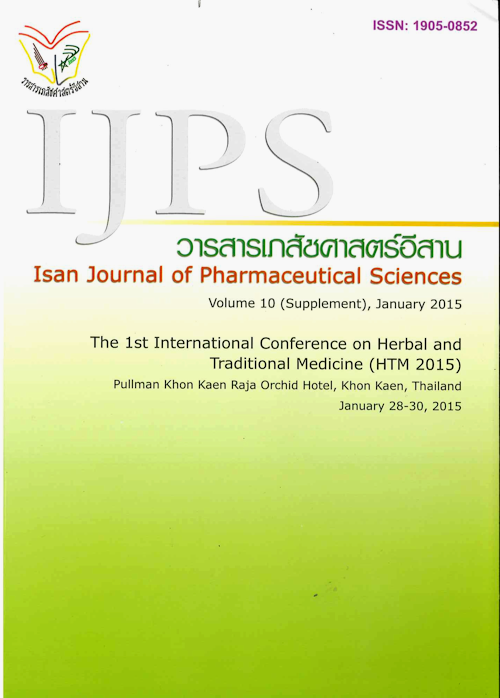Antioxidative Activities of Bran Extracts from Pigmented Rice Cultivars
Main Article Content
Abstract
Introduction : Pigmented rice bran has benefi cial effects in the human diet and potential to promote human health since it contains antioxidative compounds that can inhibit the formation and reduce the concen
trations of reactive cell-damaging free radicals. The objectives of this study were to determine the
relative antioxidative activities and identify anthocyanins in different pigmented rice brans and to
discover new rice varieties with high antioxidative potential. Methods: Rice brans cultivar Hom-nin,
Homdum-sukothai, Homnin-jakkapat, Hommae-payathongdum, Riceberry, Khawklum, Homdang-suk
othai and Saohai were extracted for anthocyanins by methanol–water (70:30, v/v) containing 0.1%
hydrochloric acid. The rice bran extraction samples were determined for anthocyanins by high perfor
mance liquid chromatography and determined antioxidant activity by 1-1 diphenyl-2-picryl hydrazyl
(DPPH). Results: The total anthocyanin contents varied signifi cantly and exhibited a range of 2-3.42
mg /g. Five anthocyanin compounds were observed and three anthocyanin compounds were chara
cterized by comparison of the spectroscopic and chromatographic properties with those of authentic
standards. The most abundant anthocyanins were cyanidin-3-glucoside in black rice, pelargonidin-
3-glucoside in blue rice, and delphinidin-3-glucoside in purple rice. The black rice bran which contained
high content of cyanidin-3-glucoside had the high antioxidative activities. Conclusion: Pigmented rice
bran cultivar Hommae-payathongdum and Hom-nin following had highest antioxidative activities. These
pigmented rice cultivars, with high antioxidative potential, may provide a source of new antioxidants,
for new improved varieties, for use in foods with pharmaceutical properties, thereby increasing rice
consumption and contributing to the prevention of diseases caused by oxidative damage to cells.
Article Details
In the case that some parts are used by others The author must Confirm that obtaining permission to use some of the original authors. And must attach evidence That the permission has been included
References
Abdel-Aal ESM, Hucl P. Composition and stability of anthocyanins in blue-grained wheat. J Agric Food Chem 2003; 51: 2174-2180.
Abdel-Aal ESM, Young JC, Rabalski I. Anthocyanin composition in black, blue, pink, purple, and red cereal grains. J Agri Food Chem 2006; 54: 4696–4704.
Awika JM, Rooney LW, Waniska RD. Anthocyanins from black sorghum and their antioxidant properties. Food Chem 2004; 90: 293–301.
Chen PN, Kuo WH, Chiang CL, Chiou HL, Hsieh YS, Chu SC. Black rice anthocyanins inhibit cancer cells invasion via repressions of MMPs and u-PA expression. Chem-Biol Interact 2006; 163: 218–229.
Giusti MM, Wrolstad RE. Characterization and measurement of anthocyanins by UV-visible spectroscopy. In: Handbook of Food Analytical Chemistry. Pigments, Colorants, Flavors, Texture, and Bioactive Food Components (Wrolstad RE, Acree TE, Decker EA, Penner MH, Reid DS, Schwartz SJ, Shoemaker CF, Smith D, Sporns P. eds.). John Wiley & Sons, Hoboken, NJ/USA; 2005.19–31.
Han KH, Sekikawa M, Shimada KI, Hashimoto M, Hashimoto N, Noda T, Tanaka H, Fukushima M. Anthocyanin-rich purple potato fl ake extract has antioxidant capacity and improves antioxidant potential in rats. Brit J Nutr 2006; 96: 1125-1133.
Han SJ, Ryu SN, Kang SS. A new 2-arylbenzofuran with antioxidant activity from the black colored rice (Oryza sativa L.) Bran. Chem Pharm Bull 2004; 52: 1365-1366.
Kim MK, Kim H, Koh K, Kim HS, Lee YS, Kim YH. Identifi cation and quantifi cation of anthocyanin pigments in colored rice. Nutr Res Pract 2008; 2: 46–49.
Klauni JE, Kamendulis LM. The role of oxidative stress in carcinogenesis. Ann Rev Pharmacol Toxicol 2004; 44: 239–267.
Mazza G, Miniati E. 1993. In: Mazza G, Miniati E. (Eds.), Anthocyanins in Fruits, Vegetables and Grains. CRC Press, Boca Raton, FL; 2004. 149–199.
Moreno YS, Sánchez GS, Hernández DR, Lobato NR. Characterization of anthocyanin extracts from maize kernels. J Chromatogr Sci 2005; 43: 483–487.
Pereira GK, Donate PM, Galembeck SE. Effects of substitution for hydroxyl in the B-ring of the flavylium cation. J Mol Struct 1997; 392: 169-179.
Ryu SN, Park SZ, Ho CT. High performance liquid chromatographic determination of anthocyanin pigments in some varieties of black rice. J Food Drug Anal 1998; 6: 729–736.
Ryu SN, Park SZ, Kang SS, Han SJ. Determination of C3G content in blackish purple rice using HPLC and UV-Vis spectrophotometer. Korean J. Crop Sci 2003; 48: 369-371.
Shimada K, Fujikawa K, Yahara K, Nakamura T. Antioxidative properties of xanthan on the autoxidation of soybean oil in cyclodextrin emulsion. J Agri Food Chem1992; 40: 945–948.
Takahashi Y, Ogra Y, Suzuki KT. Synchronized generation of reactive oxygen species with the cell cycle. Life Sci 2004; 75(3): 301–311.
Yao Y, Sang W, Zhou MJ, Ren GX. Antioxidant and a-glucosidase activity of colored grains in China. J Agri Food Chem 2010; 58: 770–774.
Zhang Z, Kou X, Fugal K, McLaughlin J. Comparison of HPLC methods for deter-mination of anthocyanins and anthocya-nidins in bilberry extracts. J Agric Food Chem 2004, 52 (4): 688–691.


